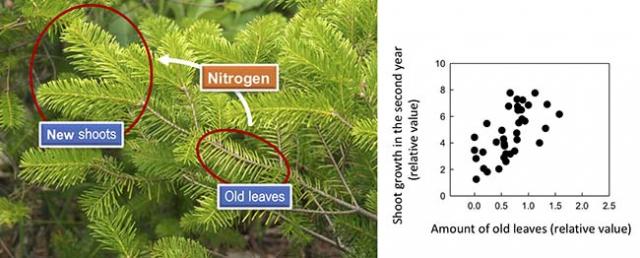Home > Research > Research Results > Research Results 2019 > Intense light stress caused by canopy tree removal suppresses the growth of Sakhalin fir seedlings for two years
Update:November 29, 2019
Main content starts here.
Intense light stress caused by canopy tree removal suppresses the growth of Sakhalin fir seedlings for two years
| Article title |
Sustained growth suppression in forest-floor seedlings of Sakhalin fir associated with previous-year springtime photoinhibition after a winter cutting of canopy trees |
|---|---|
| Author (affiliation) |
Mitsutoshi Kitao (a), Satoshi Kitaoka (b), Hisanori Harayama (a), Evgenios Agathokleous (a), Qingmin Han (b), Akira Uemura (b), Naoyuki Furuya (a), Satoshi Ishibashi (a) (a) Hokkaido Research Center, FFPRI, Sapporo, Hokkaido, Japan. (b) Department of Plant Ecology, FFPRI, Tsukuba, Ibaraki, Japan. |
| Publication Journal |
European Journal of Forest Research, 138(1):143-150, Springer, February 2019 DOI:10.1007/s10342-018-1159-3( External link ) |
| Content introduction |
Sakhalin fir (Abies sachalinensis) seedlings have a high shade tolerance, which allows them to survive in dark, understory forest environments. In the eastern part of Hokkaido where sasa‐bamboo (Sasa sp.) does not flourish because of low amounts of snowfall, there are several A. sachalinensis seedlings on the forest floor. Forest-floor seedlings can grow naturally to some extent; therefore, managements that can reduce reforestation costs by taking advantage of this natural regeneration are of valuable interest. Because winter canopy tree removal is commonly conducted in Hokkaido, forest-floor seedlings of A. sachalinensis are stressed by intense light, which causes the conifer leaves to turn brown and eventually fall. The spring growth of evergreen conifers is supported by photosynthesis conducted by the leaves that grew during the previous year (previous-year leaves). Consequently, the seedling shoots (branches + leaves) in the first year following canopy tree removal were unable to grow sufficiently owing to the damage caused by intense light and subsequent reduction in the amount of previous-year leaves. However, the shoots that developed leaves in the first year following canopy tree removal were not stressed by intense light; although when more defoliation of older leaves occurred, the shoot growth in the second year was more negatively impacted. This suggests that the reduced growth in the second year is because of the insufficient nitrogen transfer into the second-year shoots owing to the nitrogen loss through the premature fall of old leaves. To enhance the natural regeneration of forest-floor seedlings of A. sachalinensis after canopy tree removal, efforts should be made to prevent the falling of old leaves in first-year seedlings, such as providing shade by leaving a part of the canopy to reduce intense light stress.
Figure. Growth of Abies sachalinensis seedlings in the second year after removal of canopy trees. |
Copyright © Forest Research and Management Organization. All rights reserved.

